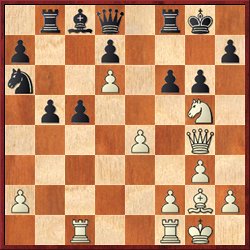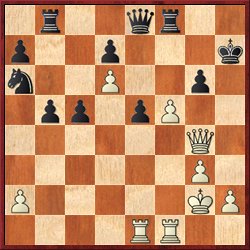“We’re looking for heroes,” said Sergey Shipov in his commentary on the World Cup today at www.chesstv.ru. What Shipov meant was that some of the players with their backs against the wall — Aronian, Grischuk, Adhiban, Moiseenko, Hammer, Dominguez, Radjabov, or Granda Zuniga — needed to play heroically to win and stay alive in the tournament. All eyes were especially on the board-one game, where top seed Levon Aronian was fighting for his tournament life against Evgeny Tomashevsky.
Well, a hero emerged — and it wasn’t Aronian. Tomashevsky gave us all a lesson in how to play for a draw against a higher-rated player. Not by trading off all the pieces, but by bravely sacrificing for the attack! Here was the crucial position of the game.
FEN: 1rbq1rk1/p2p3p/n2P1pp1/1pp3N1/4P1Q1/6P1/P4PBP/2R2RK1 w – – 0 19
Here Aronian has just played 18. … f6, intending to drive the knight back from its menacing outpost and then complete his development with … Bb7. But Tomashevsky wasn’t having any of it! He whipped out the move 19. Nxh7! Kxh7 and followed it up with the calm 20. f4!
What can I say about this idea? First, as Shipov pointed out, from the strategic point of view the sacrifice is absolutely justified, because Black has three pieces on the queenside that will take forever to get organized and come to the aid of the king.
Nevertheless, it takes incredible courage to play such a move. White is a whole piece down — not a piece for a pawn, but a whole piece. But another critically important consideration is the situation in the match. Tomashevsky only needed a draw, so for him a perpetual check is as good as a checkmate. So a defense like 20. … Bb7 21. f5 Qe8 22. e5! (which actually happened in the game) 22. … Qxe5, which would ordinarily be completely satisfactory for Black, is out of the question because White would immediately draw with 23. Qxg6+ and 24. Qh6+.
This is really a beautiful case of using the “draw odds” to your advantage, and so much better for Tomashevsky than just trying to trade material and hope for a draw in the endgame. The position is 10 times easier for him to play then it is for Aronian, and Aronian is at least 5 times more likely to make a mistake.
In fact, from Shipov’s analysis (and Houdini’s, too) it looks as if Aronian did miss one possibility to defend. Instead of 22. … Qxe5, he played 22. … Bxg2 23. Kxg2 fe 24. Rce1 (diagram).
FEN: 1r2qr2/p2p3k/n2P2p1/1pp1pP2/6Q1/6P1/P5KP/4RR2 b – – 0 24
Here Shipov asked what would happen if Black simply tries to get his knight into the game with 24. … Nb4. It seems awfully slow, but the key point is that White cannot crash through brilliantly with 25. Rxe5? because of 25. … Qxe5 26. Qxg3+ Kh8. The difference between this and the previous line is that the queen on e5 can now come back and interpose in the case of queen checks. And if 27. Rf4 — which for a moment looks fatal — Black interposes in advance with 27. … Qg7. There is no apparent way for White to make progress, and so Black’s material advantage will be decisive.
Because 25. Rxe5 doesn’t work, White has to play slowly too, but in that case the knight really does have a chance to become a relevant piece. The computer gives some mind-bending analysis after 25. Qg5 that ends with an evaluation of +2 pawns for Black, but it’s hard to know how seriously to take it.
However, this variation quickly became moot because Aronian played 24. … gf? and he never got another chance to get his queenside pieces into play. Tomashevsky achieved a draw by repetition on move 37. You might say that Tomashevsky got a little bit lucky, but luck had nothing to do with it. In this kind of position, where there are so many threats, it’s almost impossible for the defender to play perfect chess.
Another heroic game was Radjabov-Svidler, and again it was the leader who played heroically. Needing a draw to advance, Svidler took a page from Tomashevsky’s book and sacrificed a whole rook! I won’t even try to comment on this game because I didn’t understand any of it, but eventually Radjabov was forced to return the material for an endgame that was maybe slightly better, but Svidler hung on and made his draw.
Finally there were two heroes of the type that Shipov was talking about. Julio Granda Zuniga, down 1-0 agaisnt Anish Giri, pulled out a win as Black, hypnotizing Giri with his dancing knights. And in the longest game of the tournament, Alexander Grischuk banged his head against the defensive wall of Le Quang Liem for 100 moves before Le finally cracked. Around move 110 Polgar and Trent, commenting on the official website, started taking bets on when Le would resign. Trent predicted move 158, and he was almost right! Grischuk got to the Lucena position on move 152, and Le’s resignation finally came on move 154.
The players who have qualified for round 4 are Tomashevsky, Kamsky, Svidler, Gelfand, Vachier-Lagrave, and Nakamura. There will be ten playoffs tomorrow.
With Tomashevsky’s win over Aronian, the Prediction Contest is over for me and the other 29 percent of the contestants who picked Aronian to win the tournament. So I will probably not mention the Prediction Contest any more. Maybe I should have known better than to choose Aronian, because the World Cup format has been quite unfriendly to top seeds. Boris Gelfand, in 2009, remains the only top seed to win the tournament. The other winners were #3 seed Levon Aronian in 2005, #11 seed Gata Kamsky in 2007, and #9 seed Peter Svidler in 2011.
Who benefits most from Aronian’s disappearance? Well, actually, I would say Peter Svidler again. In my pre-tournament predictions I had him losing to Aronian in the semifinals. Now, if I could revise my predictions, I would have him beating Gata Kamsky in a match of former World Cup winners, and then beating Boris Gelfand in another match of former winners. But what do I know? You’ve seen how bad my first picks were, so you can probably count on this as the one thing that won’t happen.





{ 1 trackback }